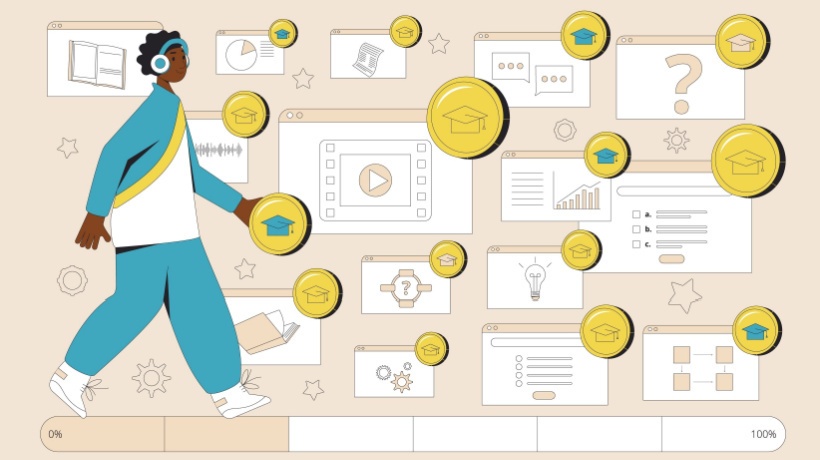How Companies Use Gamified Learning
Gamification in eLearning for corporate training involves incorporating game mechanics and elements into the learning process to enhance employee engagement, motivation, and knowledge retention. It leverages the principles of game design to make learning more enjoyable and effective. Gamified learning can be implemented across various areas in corporate training to enhance engagement and effectiveness.
Specific Scenarios Where Gamification Can Be Applied
Employee Onboarding
Gamify the onboarding process to make it more interactive and engaging for new hires. Use games to introduce company culture, policies, and procedures. Include quizzes, challenges, and simulations that help new employees grasp essential information in a fun and memorable way.
Compliance Training
Gamification can be applied to compliance training, making it more engaging and ensuring employees understand and retain critical regulatory information. Points, badges, and scenarios can be used to reinforce compliance concepts.
Soft Skills Development
Gamify training programs to develop soft skills such as communication, teamwork, leadership, and problem-solving. Role-playing scenarios, interactive simulations, and branching narratives can improve these skills.
Technical And Product Training
Implement gamified technical and product training elements to help employees better understand complex concepts. Use simulations, virtual labs, and quizzes to reinforce technical knowledge and product features.
Sales Training
Gamify sales training to motivate and engage sales teams. Incorporate scenarios that mimic real-world sales situations, use simulations for negotiation skills, and introduce friendly competition through leaderboards to encourage healthy competition.
Cybersecurity Awareness
Enhance cybersecurity training by incorporating gamified elements. Simulate phishing attacks, create scenarios to test employees’ response to security threats, and reward them for demonstrating good security practices.
Leadership Development
Gamify leadership development programs by creating scenarios where participants make decisions and face the consequences. Use role-playing games and simulations to develop decision-making and strategic thinking skills.
Language And Communication Skills
Use gamification to improve language proficiency and communication skills. Incorporate language learning games, interactive conversations, and challenges that encourage employees to practice and improve their language skills.
Change Management
When organizations undergo a change, such as adopting new technologies or restructuring, gamification can help employees adapt more smoothly. Create games that simulate change scenarios, educate employees on the reasons behind the changes, and reward them for successfully adapting.
Performance Management
Implement gamified elements in performance management training. Create goal-setting games, use leaderboards to track and reward progress, and incorporate simulations that allow employees to practice performance review conversations.
Diversity And Inclusion Training
Gamify diversity and inclusion training to create a more inclusive workplace culture. Use scenarios and simulations that highlight the importance of diversity, challenge biases, and promote understanding.
Performance And Content Gamification In eLearning For Corporate Training
The corporate learning scenarios can further be divided into two categories, performance gamification and content gamification. Performance gamification is often used in sales environments, customer service, and other areas where measurable outcomes and achievements are crucial. Content gamification is commonly employed in eLearning courses, employee training programs, and onboarding processes to make the learning experience more interactive and enjoyable.
Performance And Content Gamification Strategies
Performance gamification focuses on using game elements to enhance employee performance, motivation, and engagement within the workplace. The goal is to drive desired behaviors, achievements, and outcomes. Critical components of performance gamification include:
- Rewards and recognition
Employees earn rewards, badges, or other forms of recognition for achieving specific performance milestones or demonstrating desired behaviors. - Leaderboards
Publicly display rankings to foster healthy competition among employees. Leaderboards showcase top performers and encourage others to strive for excellence. - Challenges and goals
Set challenges or goals for employees to accomplish within a specified time frame. This can include meeting sales targets, completing projects, or achieving specific metrics. - Feedback mechanisms
Provide instant feedback on performance to guide employees toward improvement. Constructive feedback reinforces positive behaviors and helps employees understand their progress. - Incentives
Introduce tangible incentives such as bonuses, promotions, or additional benefits tied to exceptional performance. These incentives can motivate employees to excel in their roles consistently.
Content gamification, on the other hand, revolves around incorporating game elements into the learning content itself. The primary aim is to enhance the learning experience, making it more engaging, enjoyable, and effective. Critical components of content gamification in eLearning for corporate training include:
- Points and badges
Learners earn points and badges for completing modules, quizzes, or activities. This provides a sense of accomplishment and progression. - Quizzes and assessments
Transform traditional assessments into interactive quizzes and challenges. Timed quizzes, scenario-based assessments, and knowledge checks add a gaming dimension to the learning process. - Storytelling and scenarios
Integrate narratives, storylines, and scenarios into the learning content to create a more immersive and relatable experience. Learners can navigate through challenges and make decisions that affect the course of the narrative. - Simulations
Interactive simulations allow learners to apply theoretical knowledge in practical, real-world scenarios. Simulations are particularly effective for technical and skills-based training. - Progress tracking
Displaying progress bars, visual indicators, or levels can help learners track their advancement through the content. This provides a sense of achievement and encourages continued participation.

